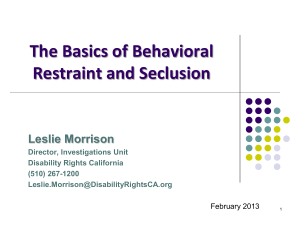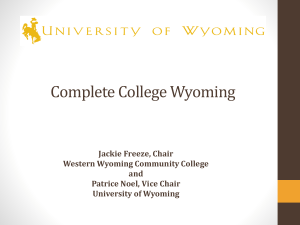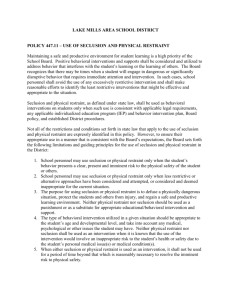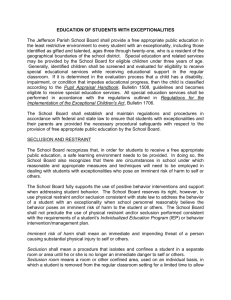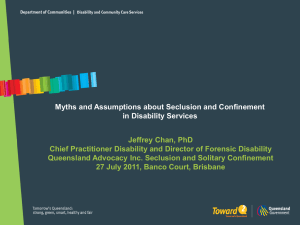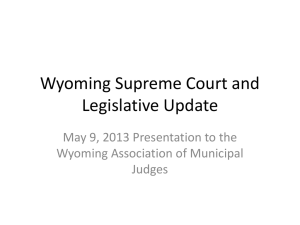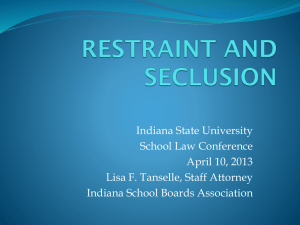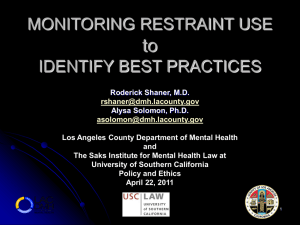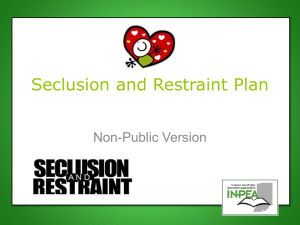2011 Legal Update - Wyoming School Boards Association
advertisement
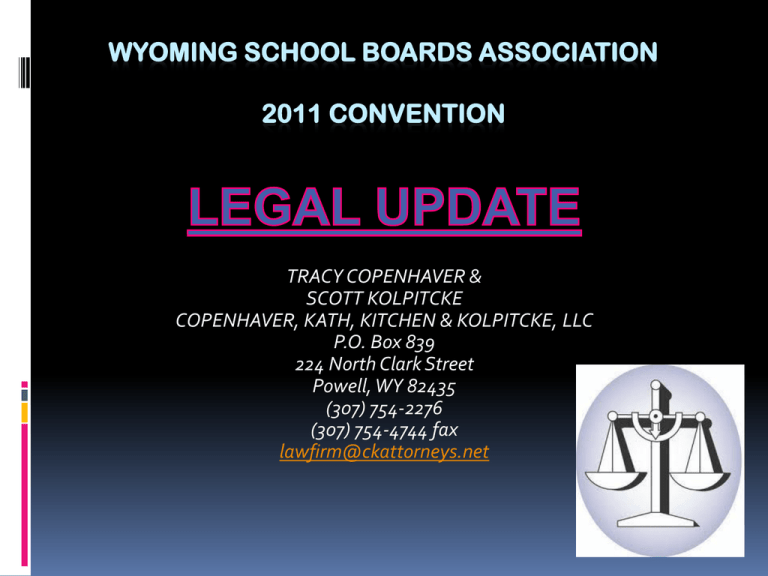
WYOMING SCHOOL BOARDS ASSOCIATION 2011 CONVENTION TRACY COPENHAVER & SCOTT KOLPITCKE COPENHAVER, KATH, KITCHEN & KOLPITCKE, LLC P.O. Box 839 224 North Clark Street Powell, WY 82435 (307) 754-2276 (307) 754-4744 fax lawfirm@ckattorneys.net Statutory Changes – Evaluation – Termination – Suspension Contract Length: 12-Month or 9-Month Public Records/Open Meetings Recreation Districts Drug Testing Seclusion & Restraint Student 1st Amendment Teacher Termination, Dismissal and Suspension: Statutory Changes Definitions: 1. Continuing contract teacher. New language adds “has performed satisfactorily on performance evaluations implemented by the district”. 2. Suspension. New language: “by the superintendent with pay pending: 1) the investigation of an allegation of misconduct, which investigation shall not exceed 30 days”. Duties of the board of trustees. W.S. 21-3-110(xix). Based upon student achievement measures established by the State Board, performance evaluations shall serve as a basis for improvement of instruction, measurement of both individual teacher performance and professional growth and development and the performance level of all teachers within the school district, and as documentation for unsatisfactory performance for dismissal, suspension and termination proceedings. A performance evaluation is required annually for continuing contract teachers and bi-annually for initial contract teachers. Merely allowing a teacher to set a goal and determine whether the teacher reach his/her goal is no longer adequate. W.S. 21-7-104. Employment of continuing contract teacher. Subject to satisfactory performance evaluations a continuing contract teacher shall be employed by each school district on a continuing basis . . . W.S. 21-7-106. Notice of recommendation of termination. A continuing contract teacher shall be notified of a recommendation of termination . . . on or before April 15. The teacher may request a hearing on the recommendation before an independent hearing officer through the Office of Administrative Hearings. W.S. 21-7-110. Effective July 1, 2012 the Legislature has added as grounds for suspension, dismissal and termination, inadequate performance as determined through annual performance evaluation tied to student academic growth completed in accordance with W.S. 21-3-110(a)(xvii) – (xix) and conviction of a felony. DIFFICULT PERSONNEL DECISIONS _______________________ DOING WHAT IS RIGHT THE RIGHT WAY Rules of Practice Governing Hearings and Contested Cases Before the Board of Trustees, Policy BEE, Regulation BEE-R. APA rule adoption process. There are three good reasons to be a teacher - June, July, and August. ~Author Unknown 12-Month Employment? Employees: what is the last date of employment? Health insurance ? Unemployment ? Don’t get caught in a lose-lose situation. If policy provides for payment over 12 months, it should specify that in the event of termination, final payment shall be made within five (5) days of termination and benefits shall cease. Proposed Changes to the Wyoming Public Records Act and Wyoming Open Meetings Act The Joint Interim Judiciary Committee drafted several proposed changes to the Wyoming Open Meetings and Public Records Act, and met on October 13 to finalize their proposals. Proposed Changes to the Open Meetings Act: 1. The definition of a “meeting” would change to specifically include meetings conducted telephonically, electronically, and in any other manner where the members are able to communicate with each other and the public at the same time. The definition also provides that sequential communication should not be used to avoid conducting a meeting. 2. Parties requesting notices of meetings must make their request in writing. Notice of special meetings may be verbal, electronic or written, and must be issued at least 8 hours prior to the start of the meeting. Proof of delivery of verbal notice is permitted by affidavit. Public Records Act Changes: 1. Clarifies that the term “Public Records” includes e-mail communications and other communications of a physical form. Voice mails and text messages would not be public records. Applications for access to public records would have to be in writing, or in the discretion of the custodian, a verbal application is acceptable. The Joint Judiciary Committee also rejected a proposal to allow for a “deliberate privilege”. This would have allowed communications which are “integral parts of the decision-making process, including suggestions, advisory opinions, recommendations, projections, proposals and deliberations” to remain confidential. Recent Cases Involving Public Records: •Laramie County School District No. 1 v. Cheyenne Newspapers, Inc. (March 23, 2011) •Sheridan Newspapers, Inc. v. City of Sheridan (1983): “The [government] should be ever mindful that theirs is public business and the public has a right to know how its servants are conducting its business. Furthermore, it is for government to remember that the written, viewing and broadcasting press are the eyes and ears of the people. The citizenry must be permitted to hear and see what public officers and their employees say and do . . .” Recent Cases Involving Open Meetings: •Raehal v. Carbon County School District No. 2 (Dist. Court, Carbon County, April 2011). •Mosbey, et al. v. Board of Co. Commissioners for Sweetwater County, et al. v. Van Matre, District Court, Sweetwater County (March 2011). The Mayor, in an interview with the newspaper, said the charge was “frivolous bull ____”. W.S. 16-4-403(a): “Action taken at a meeting not in conformity with this act is null and void and not merely voidable.” Recreation Districts A recreation district is NOT a school district. It is a separate legal entity. W.S. 18-9-201. The governing body of a school district may establish a system of public recreation as provided by W.S. 18-9-101(a)(i) – (iii) and shall appoint a board of trustees to control, maintain and supervise the properties. 1. The board shall be comprised of not fewer than five members serving five-year terms, which shall be staggered. 2. The board may adopt rules and regulations in accordance with the Wyoming Administrative Procedures Act (this denotes it is a governmental entity subject to the same rules as the school district). Any monies accruing from tax levy made by the governing body involved in the recreation system shall be credited to the board and may be expended by them for the maintenance, improvement, development, operation, management, and conduct of the system. The recreation board has authority to acquire, equip and maintain land, buildings or other recreational facilities (again denoting a separate legal entity). Recreation board referenced in W.S. 18-9-102 specifically provides that upon filing the certificate showing organization of the recreation district, the board of trustees is a body corporate empowered to sue and be sued. Insurance ? Student Drug Testing Hageman v. Goshen County School District No. 1. June 2011 1. Drug tests mandated by school district’s policy constitute searches for the purpose of Constitutional search and seizure analysis. Holding: The school district’s student activity participant drug testing policy did not violate the search and seizure provisions of either the State or Federal Constitutions. Goshen County School District No. 1’s drug testing policy required all students, grades 7-12 who desired to participate in activities, including activities not sanctioned by the Wyoming High School Activities Association, to consent to random drug and alcohol testing. The school’s role is custodial and tutelory, permitting a degree of supervision and control that could not be exercised over free adults. In order to maintain safety and welfare, schools are afforded the flexibility to impose rules on students that might be inappropriate for adults. In order for policy to be permissible under the Constitution, it was sufficient if the school district established that there was a rational connection between the policy chosen and the problem identified. Goshen County School District No. 1 participated in the “Wyoming Youth Risk Surveys” which for several years revealed a serious prevalence of alcohol and drug use among students. In 2008 the district participated in the “Wyoming Prevention Needs Assessment State Profile Report”. 6th graders: 26% used alcohol 4% used inhalants within the past 30 days 3% binge drinkers 8th graders: 33% were at risk of harm from drugs 10th grade: 12th grade: 41% at risk of harm from drugs 52% at risk of harm from drugs 47% had friends who 40% expressed intent used drugs to use District’s drug policy does not violate the Equal Protection clause of either the Wyoming Constitution or the Federal Constitution. Drug Testing of Staff The 4th Amendment to the U.S. Constitution states: “The right of the people to be secure in their persons, houses, papers, and effects, against unreasonable searches and seizures, shall not be violated, and no Warrants shall issue, but upon probable cause, supported by Oath or affirmation, and particularly describing the place to be searched, and the person or things to be seized.” The Wyoming Constitution also protects individuals against unreasonable searches and seizures. The Federal courts have held that drug tests are a form of search, and that the 4th Amendment generally protects public employees (including school district employees) from warrantless drug tests. There are exceptions. One exception is for testing based on “reasonable suspicion.” Smith County School District v. Barnes (Miss. App. Ct., September 2011). In order to implement drug testing based on reasonable suspicion, the school district must adopt a policy which describes the process. The process must describe the method for identifying the specific, articulable signs that an employee may be under the influence of a controlled substance. For example, if the employee smells of marijuana or alcohol, exhibits poor motor skills, bloodshot eyes, dilated pupils, slurred speech and/or other similar specific signs of impairment, the supervisor may request that the employee submit to testing. Seclusion and Restraint W.S. 21-3-110(a)(xxxi) mandates that school districts adopt a policy and training procedures regarding the use of seclusion and restraint in schools. 1. Required notification of parent each time. 2. Prohibition of the use of locked seclusion. 3. Comply with all requirements provided by rule and regulation adopted by the State Superintendent. 4. Applies to all students, not just special education. “Restraint” means the use of physical force, with or without the use of any physical device or material, to restrict the free movement of all or a portion of a student’s body. “Restraint” does not include comforting or calming a student, holding a hand or arm of a student to escort the student if the student is complying, intervening in a fight, or using an assistive or protective device prescribed by an appropriately trained professional or professional team. “Seclusion” means removing a student from a classroom or other school activity and isolating the student in a separate area. “Seclusion” does NOT include a student-requested break or inschool suspension, detention or other appropriate disciplinary measure. Seclusion: 1. “Seclusion from the learning environment” means visually or auditorally isolating the student from the classroom or other school activity away from peers in an area that obstructs the student’s ability to participate in regular classroom or school activities. 2. “Isolation room” means purposefully placing the student in an enclosed room built in compliance with all relevant health and safety codes. Isolation room physical space requirements: a. b. c. d. Continuous visual and auditory monitoring; Adequately lighted; Adequately ventilated; Temperature within the normal comfort range; e. Clean and free of objects and fixtures that could be potentially dangerous; f. Wall and floor coverings designed to prevent injury; g. Capable of being opened from the inside immediately upon the release of the security mechanism held in place by constant human contact; h. Adequate width, length and height to allow student to move about and recline comfortably. Training: •All staff shall receive training in the prevention of physical restraint and seclusion, including skills training relating to positive behavior supports, safe physical escort, conflict prevention, de-escalation and conflict management. •Limited classified and certified staff will receive training in the appropriate use of physical restraint. •All staff shall also annually receive training and information regarding the implementation of the seclusion and restraint policy. First Amendment Issues: Bullies Have Rights Recent Cases: •Zamecnik v. Indian Prairie School District #204, 636 F.3d 874 (7th Cir. 2011). •Layshock v. Hermitage School District (3rd Cir. 2011). •Patterson v. Hudson Area Schools, 551 F.3d 438 (6th Cir. 2009). Bottom line: bullying, harassment and intimidation are serious issues, and schools should investigate and address them. Schools also need to understand the limits of their authority, and recognize that they cannot discipline students for speech that is protected by the First Amendment. QUESTIONS? Copenhaver, Kath, Kitchen & Kolpitcke, LLC (307) 754-2276 lawfirm@ckattorneys.net WSBA – Legal Services


